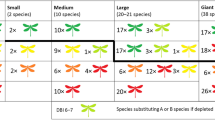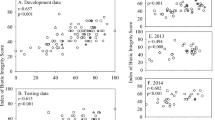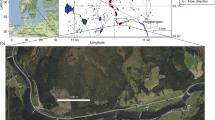Abstract
Prioritizing and assessing the condition of sites for conservation action requires robust and ergonomic methodological tools. We focus here on prioritizing freshwater sites using two promising biodiversity indices, the Dragonfly Biotic Index (DBI) and Average Taxonomic Distinctness (AvTD). The AvTD had no significant association with either species richness or endemism. In contrast, the DBI was highly significantly associated with species richness and endemism, although the strengths of the associations were weak. These associations are related to how the sub-indices in the DBI are weighted, and how species are distributed geographically. Additionally, the DBI was found to be very useful for site selection based on its ability to measure ecological integrity, combined with level of threat, at multiple spatial scales. The AvTD was found to be useful principally for regional use. As the DBI is a low-cost, easy-to-use method, it has the additional use as a method for assessing habitat quality and recovery in restoration programs. The DBI operates at the species level, and is therefore highly sensitive to habitat condition and has great potential for environmental assessment and monitoring freshwater biodiversity and quality. Practical, worked examples of river restoration are given here. In view of the ease and versatility by which the DBI can be employed, we recommend its testing and possible integration into freshwater management and conservation schemes elsewhere in the world.







Similar content being viewed by others
References
Bried JT, Herman BD, Ervin GN (2007) Umbrella potential of plants and dragonflies for wetland conservation: a quantitative case study using the umbrella index. J Appl Ecol 44:833–842. doi:10.1111/j.1365-2664.2007.01299.x
Chovanec A (2000) Dragonflies (Insecta: Odonata) as indicators of the ecological integrity of aquatic systems-a new assessment approach. Verh Int Verein Limnol 27:887–890
Chovanec A, Waringer J (2001) Ecological integrity of river-floodplain systems-assessment by dragonfly surveys (Insecta: Odonata). Regul Rivers Res Manage 17:493–507. doi:10.1002/rrr.664
Clarke KR, Warwick RM (1998) A taxonomic distinctness index and its statistical properties. J Appl Ecol 35:523–531. doi:10.1046/j.1365-2664.1998.3540523.x
Clarke KR, Warwick RM (2001) Change in marine communities: an approach to statistical analysis and interpretation, 2nd edn. PRIMER-E, Plymouth
Dickens CWS, Graham PM (2002) The South African Scoring System (SASS) version 5 rapid bioassessment method for rivers. Afr J Aquat Sci 27:1–10
Dijkstra K-DB, Samways MJ, Simaika JP (2007) Two new relict Syncordulia species found during museum and field studies of threatened dragonflies in the Cape Floristic Region (Odonata: Corduliidae). Zootaxa 1467:19–34
Dinerstein E, Wikramanayake ED (1993) Beyond “hotspots”: how to prioritize investments to conserve biodiversity in the Indo-Pacific region. Conserv Biol 7:53–65. doi:10.1046/j.1523-1739.1993.07010053.x
Ellingsen KE, Clarke KR, Somerfield PJ, Warwick RM (2005) Taxonomic distinctness as a measure of diversity applied over a large scale: the benthos of the Norwegian continental shelf. J Anim Ecol 74:1069–1079. doi:10.1111/j.1365-2656.2005.01004.x
Environmental Survey Research Institute (ESRI) (1999) ArcView 3.2a. http.esri.com
Environmental Survey Research Institute (ESRI) (2006) ArcGIS 9.2. http.esri.com
Fleishman E, Noss RF, Noon BR (2006) Utility and limitations of species richness metrics for conservation planning. Ecol Indic 6:543–553. doi:10.1016/j.ecolind.2005.07.005
Graham CH, Hijmans RJ (2006) A comparison of methods for mapping species ranges and species richness. Glob Ecol Biogeogr 15:578–587. doi:10.1111/j.1466-8238.2006.00257.x
Heino J, Mykrä H, Hämäläinen H, Aroviita J, Muotka T (2007) Responses of taxonomic distinctness and species diversity indices to anthropogenic impacts and natural environmental gradients in stream macroinvertebrates. Freshw Biol 52:1846–1861. doi:10.1111/j.1365-2427.2007.01801.x
International Union for Conservation of Nature and Natural Resources (IUCN) (2001) IUCN Red List Categories and Criteria: Version 3.1. IUCN SSC Species Survival Commission, IUCN, Gland Switzerland
Jennings MD, Hoekstra J, Higgins J, Boucher T (2008) A comparative measure of biodiversity based on species composition. Biodivers Conserv 17:833–840. doi:10.1007/s10531-008-9322-7
Lamoreux JF, Morrison JC, Ricketts TH, Olson DM, Dinerstein E, McKnight MW et al (2006) Global tests of biodiversity concordance and the importance of endemism. Nature 440:212–214. doi:10.1038/nature04291
Luck GW, Daily GC, Ehrlich PR (2003) Population diversity and ecosystem services. Trends Ecol Evol 18:331–336. doi:10.1016/S0169-5347(03)00100-9
Magoba RN, Samways MJ (2009) Restoration of aquatic macroinvertebrate assemblages through large-scale removal of invasive alien trees. In preparation
Magurran AE (2004) Measuring biological diversity. Blackwell, Oxford
McGeoch MA (2007) Insects and bioindication: theory and progress. In: Stewart AJA, New TR, Lewis OT (eds) Insect conservation biology. CABI, Wallingford, pp 144–174
Midgley DC, Pitman WV, Middleton BJ (1994) Surface water resources of South Africa 1990: WRC report no. 298/1/94. Water. Resource Commission, Pretoria, South Africa
Mouillot D, Gaillard S, Aliaume C, Verlaque M, Belsher T, Troussellier M et al (2005) Ability of taxonomic diversity indices to discriminate coastal lagoon environments based on macrophyte communities. Ecol Indic 5:1–17. doi:10.1016/j.ecolind.2004.04.004
Niba AS, Samways MJ (2006a) Remarkable elevational tolerance in an African dragonfly (Odonata) assemblage. Odonatologica 35:265–280
Niba AS, Samways MJ (2006b) Development of the concept of ‘core resident species’ for quality assurance of an insect reserve. Biol Conserv 15:4181–4196
Oertli B (2008) The use of dragonflies in the assessment and monitoring of aquatic habitats. In: Córdoba-Aguilar A (ed) Dragonflies: model organisms for ecological and evolutionary research. Oxford University Press, Oxford
Orme CDL, Davies RG, Burgess M, Eigenbrod F, Pickup N, Olson VA et al (2005) Global hotspots of species richness are not congruent with endemism or threat. Nature 436:1016–1019. doi:10.1038/nature03850
Ott J (2008) Dragonflies and climate change. Pensoft, Sofia
Ott J, Schorr M, Trockur B, Lingenfelder U (2007) Species protection programme for the Orange-spotted emerald (Oxygastra curtisii, Insecta: Odonata) in Germany—the example of the River Our population. Insect Ecology and Conservation Monographs, Pensoft, Bulgaria
Pinhey E (1984) A survey of the dragonflies (Odonata) of South Africa. Part 1. Zygoptera. J Entomol Soc S Afr 47:147–188
Pinhey E (1985) A survey of the dragonflies (Odonata) of South Africa. Part 2. Anisoptera. J Entomol Soc S Afr 48:1–48
Prendergast JR, Quinn RM, Lawton JH, Eversham BC, Gibbons DW (1993) Rare species, the coincidence of diversity hotspots and conservation strategies. Nature 365:335–337. doi:10.1038/365335a0
Pressey RL, Humphries CJ, Margules CR, Vane-Wright RI, Williams PH (1993) Beyond opportunism: key principles for systematic reserve selection. Trends Ecol Evol 8:124–128. doi:10.1016/0169-5347(93)90023-I
Price ARG, Keeling MJ, O’Callaghan CJ (1999) Ocean-scale patterns of ‘biodiversity’ of Atlantic asteroids determined from taxonomic distinctness and other measures. Biol J Linn Soc Lond 66:187–203
Samways MJ (2008) Dragonflies and damselflies of South Africa. Pensoft, Sofia
Samways MJ, Grant PBC (2006a) Honing Red List assessments of lesser-known taxa in biodiversity hotspots. Biol Conserv 16:2575–2586
Samways MJ, Grant PBC (2006b) Regional response of Odonata to river systems impacted and cleared of invasive alien trees. Odonatologica 35:297–303
Samways MJ, Taylor S (2004) Impacts of invasive alien plants on red-listed South African dragonflies (Odonata). S Afr J Sci 100:78–80
Schmidt E (1985) Habitat linearization, characterization and bioindication by a ‘Representative Spectrum of Odonata Species (RSO). Odonatologica 14:127–133
Schulze RE, Hallowes LA, Horan MJC, Lumsden TG, Pike A, Thornton-Dibb S et al. (2006) South African quaternary catchments database. In: Schulze RE (ed) South African atlas of climatology and agrohydrology. Water Research Commission, Pretoria, RSA, WRC Report 1489/1/06, Sect. 2.3
Simaika JP, Samways MJ (2008a) Valuing dragonflies as service providers. In: Córdoba-Aguilar A (ed) Dragonflies: model organisms for ecological, evolutionary research. Oxford University Press, Oxford, pp 109–123
Simaika JP, Samways MJ (2008b) Description of final instar larvae of Ecchlorolestes Sélys (Zygoptera: Synlestidae) from South Africa. In preparation
Smith J, Samways MJ, Taylor S (2007) Assessing riparian quality using two complementary sets of bioindicators. Biol Conserv 16:2695–2713
South African National Botanical Institute (SANBI) Biodiversity GIS Unit http://bgis.sanbi.org. Last visited: February 2008
SPSS Inc (2004) SPSS version 13.0 for windows. SPSS Inc, Chicago
Virolainen KM, Suomi T, Suhonen J, Kuitenen M (1998) Conservation of vascular plants in single large and several small mires: species richness, rarity and taxonomic diversity. J Appl Ecol 35:700–707
Warwick RM, Clarke KR (1995) New ‘biodiversity’ measures reveal a decrease in taxonomic distinctness with increasing stress. Mar Ecol Prog Ser 129:301–305. doi:10.3354/meps129301
Warwick RM, Clarke KR (2001) Practical measures of marine biodiversity based on relatedness of species. Oceanogr Mar Biol Ann Rev 39:207–231
Wilkinson DM (1999) The disturbing history of intermediate disturbance. Oikos 84:145–147. doi:10.2307/3546874
Acknowledgments
We would like to thank René Gaigher, who assisted with data entry and database management. We are also grateful to Jesse Kalwij and Aruna Manrakhan for comment on an early draft of the manuscript, and two anonymous referees for their valuable insight. Bob Clarke (Primer-E Ltd) provided statistical advice. This is a contribution to the EU/ALARM Assessing Large Scale Environmental Risks for Biodiversity with Tested Methods), Project No. GOCE-CT-2003-506775.
Author information
Authors and Affiliations
Corresponding author
Rights and permissions
About this article
Cite this article
Simaika, J.P., Samways, M.J. An easy-to-use index of ecological integrity for prioritizing freshwater sites and for assessing habitat quality. Biodivers Conserv 18, 1171–1185 (2009). https://doi.org/10.1007/s10531-008-9484-3
Received:
Accepted:
Published:
Issue Date:
DOI: https://doi.org/10.1007/s10531-008-9484-3




